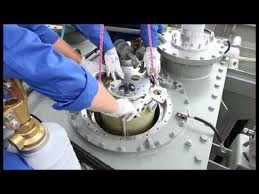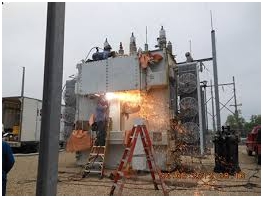Load tap changer maintenance is the most important aspect that governs the reliability of a transformer.
There are a few recommendations in place that play a critical role in the maintenance of load tap changers (LTC). And today, one of our members kindly sent us an article about it.
Oil Used LTC
In this kind of load tap changers, oil is used for arc-quenching purpose. Depending on the load of the transformer and other parameters, arcs keep producing at the arcing switches and contacts. These arcs tend to carbonize the switching oil which in turn leads to corrosion of the internal components of the LTC.
The intensity of the oil that is contaminated due to these arcs generally depends on the number operational hours, operating current on the LTC and last but not the least, quality of the oil used for insulation purposes.
It is recommended that a regular overhaul and oil replacement is done, in order to ensure the durability of the load tap changer and its components.
Vacuum Type LTC
In this kind of LTC’s, vacuum interrupters are used for arc-quenching purpose. Depending on the load of the transformer and other parameters, arcs keep producing at the arcing switches and contacts.
The arcs thus produced at the switching taps tend to decrease the life of ‘contacts’ integrated to the interrupters and also produce stress on some of the most important mechanical parts of the LTC.
Though these types of LTC’s require less maintenance, one should keep in mind that a continuous online monitoring of the contacts and stressed mechanical parts is necessary to ensure that these important components last long.
Maintenance of LTC’s and their Inspection schedules depend on the following parameters:
- LTC’s type
- Rated through-current of the LTC
- Experience in the field
- Operating conditions
Note 1: Recommended maintenance of each individual LTC and its inspection schedule are mentioned in the user manual and one has to abide by them, not only to ensure its durability but also to keep its manufacturer’s warranty intact.
Note 2: Once you find a defect in the LTC, you can call up the professionals and start the maintenance process immediately, unless it is located in a place where there are some extreme tropical/subtropical climatic conditions.
If this is the case, then you will have to prepare a maintenance plan and perform it when the climatic conditions are friendly. In certain countries, maintenance is performed only when the relative humidity falls below 75%.
Repairing And Replacing LTC’s:
In general, in most power utility companies, the average life of a transformer is reported to be approximately 30 years. But in reality, a transformer’s durability can be much more. But the power utility companies tend to replace the transformers after every 25 to 30 years in a bid to increase the reliability of their ageing networks.
This has almost become like a policy for all modern power generating companies. This will only increase the investment costs and the consumers end up paying more for these unwanted expenses made by their respective power providers.
Repairing
However, with proper maintenance and regular inspections, power utilities can increase the life of the transformers for up to 20 years in addition to their average life span of 30 years.
This can be achieved by performing some minor improvements in the transformer mechanism, like increasing the load capacity, using better insulation techniques, decreasing the noise levels, using advanced filters, replacing the bushings of the LTC’s regularly, etc., can tremendously increase the life of a transformer.
Replacement
LTC replacement becomes inevitable only when, the LTC has become too old and risky to operate, or the spare parts of the recommended load tap changer are no longer available.
In cases, where the recommended type of load tap changer is no longer available, buying a new and more efficient LTC and then re-designing the transformer according to the requirements of the new LTC is not a bad idea at all.
Conclusion
As discussed above, maintaining the existing LTC in a timely manner, rather than replacing it periodically, can save you a lot of money, downtime and hassles of re-designing the existing transformer.
Here, what you have to keep in mind is, whenever you schedule a maintenance program, make sure that it is done by the experts coming from the manufacturer’s side. This ensures proper and professional maintenance, along with an extended warranty given by the manufacturer.
Can you think about other ways of make the transformers even more reliable?



I agree that if you’re planning a maintenance program for the transformer, it’s a good idea to work with an expert. It sounds very expensive to replace if anything goes wrong. From my point of view, it might cost a bit money, but it’s sounds worth it in the long run.